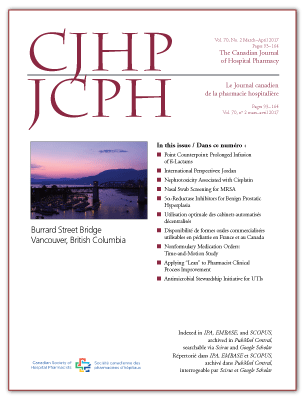Risk Factors for Nephrotoxicity Associated with Cisplatin
DOI:
https://doi.org/10.4212/cjhp.v70i2.1641Keywords:
cisplatin, nephrotoxicity, renal failure, hydrochlorothiazide, angiotensin-converting enzyme inhibitor, nonsteroidal anti-inflammatory drug, cisplatine, néphrotoxicité, insuffisance rénale, hydrochloro-thiazide, inhibiteur de l’enzyme de conversionAbstract
ABSTRACT
Background: Cisplatin-induced nephrotoxicity occurs in about one-third of patients who receive this chemotherapy drug. In late 2012, the study institution began measuring serum creatinine on day 7 after administration of cisplatin to identify patients with acute renal failure.
Objective: To evaluate the extent of nephrotoxicity associated with cisplatin and the influence of risk factors for nephrotoxicity.
Methods: This retrospective study involved patients who received a first cycle of cisplatin-based chemotherapy between November 1, 2012, and November 1, 2013. Patients’ medical records were reviewed to determine the increase in creatinine level (graded according to the National Cancer Institute Common Terminology Criteria for Adverse Events) and the influence of certain prespecified risk factors, such as age, concomitant medications, initial dose of cisplatin, and related medical conditions.
Results: Among the 80 patients evaluated, 14 (17%) experienced no increase in the level of serum creatinine (grade 0), 44 (55%) experienced a grade 1 increase, 19 (24%) a grade 2 increase, and 3 (4%) a grade 3 increase; no patients experienced a grade 4 increase. Patients with the greatest risk of a grade 2 or 3 increase were those treated with hydrochlorothiazide (odds ratio [OR] 9.35, 95% confidence interval [CI] 2.49 to 35.14) or an angiotensin-converting enzyme inhibitor or angiotensin II receptor blocker (OR 5.02, 95% CI 1.76 to 14.32). After adjustment, only hydrochlorothiazide was associated with an increased risk of nephrotoxicity (OR 5.39, 95% CI 1.04 to 28.07). Among patients taking hydrochlorothiazide, the average incremental increase in serum creatinine was 59.9 μmol/L (95% CI 34.3 to 85.4 μmol/L).
Conclusions: Taking hydrochlorothiazide was associated with a significant increase in serum creatinine following cisplatin therapy. On the basis of these results, patients should stop taking hydrochlorothiazide before undergoing cisplatin-based chemotherapy.
RÉSUMÉ
Contexte : La néphrotoxicité associée au cisplatine se produit chez environ le tiers des patients qui reçoivent ce médicament de chimiothérapie. À la fin de 2012, l’établissement de santé des auteurs a commencé à mesurer la créatinine sérique au jour 7 après l’administration de cisplatine afin de repérer les patients atteints d’insuffisance rénale aiguë.
Objectif : Évaluer le degré de la néphrotoxicité associée au cisplatine et déterminer si des facteurs de risque favorisent cette néphrotoxicité. Méthodes : Cette étude rétrospective a été menée auprès de patients ayant subi un premier cycle de chimiothérapie à base de cisplatine entre le premier novembre 2012 et le premier novembre 2013. Les dossiers médicaux
des patients ont été examinés afin de détecter les cas d’augmentation de créatinine sérique (qui ont été classés selon les critères pour une terminologie commune des événements indésirables du National Cancer Institute) et l’influence de facteurs de risque préétablis (âge, médicaments concomitants, dose initiale de cisplatine et pathologies associées).
Résultats : Parmi les 80 patients analysés, 14 (17 %) n’affichaient aucune augmentation du taux de créatinine sérique (degré 0), 44 (55 %) présentaient une augmentation de degré 1, 19 (24 %) affichaient une augmentation de degré 2 et 3 (4 %) présentaient une augmentation de degré 3; aucun ne présentait une augmentation de degré 4. Les patients qui couraient le plus grand risque de connaître une augmentation de degré 2 ou 3 étaient ceux traités avec l’hydrochlorothiazide (risque relatif approché [RRA] de 9,35, intervalle de confiance [IC] à 95 % de 2,49 à 35,14) ou d’un inhibiteur de l’enzyme de conversion de l’angiotensine ou d’un bloqueur des récepteurs de l’angiotensine II (RRA de 5,02, IC à 95 % de 1,76 à 14,32). Après ajustement, seul l’hydrochlorothiazide était associé à une augmentation du risque de néphrotoxicité (RRA de 5,39, IC à 95 % de 1,04 à 28,07). Parmi les patients qui prenaient de l’hydrochlorothiazide, l’augmentation différentielle moyenne de créatinine sérique était de 59,9 μmol/L (IC à 95 % de 34,3 à 85,4 μmol/L).
Conclusions : La prise concomitante d’hydrochlorothiazide a été associée à une augmentation significative de la créatinine sérique après un traitement de cisplatine. Considérant ces résultats, les patients devraient cesser de prendre de l’hydrochlorothiazide avant de recevoir une chimiothérapie à base de cisplatine.
Downloads
Published
Issue
Section
License
After publication of a manuscript in the CJHP, the authors of the manuscript must obtain written permission from the CSHP (publications@cshp.ca) before reproducing any text, figures, tables, or illustrations from the work in future works of their own. If a submitted manuscript is declined for publication in the CJHP, all said rights shall revert to the authors. Please note that any forms (e.g., preprinted orders and patient intake forms) used by a specific hospital or other health care facility and included as illustrative material with a manuscript are exempt from this copyright transfer. The CJHP will require a letter from the hospital or health care facility granting permission to publish the document(s).
Copyright © Canadian Society of Hospital Pharmacists.









